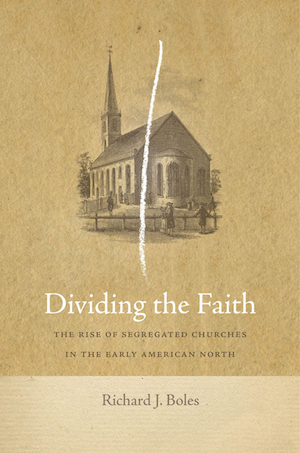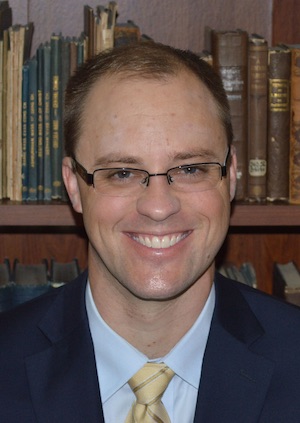By Paul Kiefer
In 1805, a vocal abolitionist and rising preacher named Thomas Paul helped establish the first African Baptist Church in Boston’s Beacon Hill neighborhood. Today, the building is the oldest Black church still standing in the United States. While the Black neighborhood that it once served is long gone, it stands as a reminder of a tipping point in American racial history, and one that Oklahoma State University history professor and Phi Beta Kappa member Richard J. Boles addresses in Dividing the Faith: The Rise of Segregation in the Early American North (NYU Press, 2020).
Boles’ passion for history is in his blood: his mother was a history major, as was his grandmother. When he landed at Boston College for his undergraduate studies, he followed in his mother’s footsteps, earning a bachelor’s degree in history and induction by the Omicron of Massachusetts, the school’s chapter of Phi Beta Kappa, before returning for a master’s degree. Upon graduation, Boles found his way into a job with the National Park Service in Boston, for which he led tours of Boston’s Black Heritage Trail—including the first African Church.
But as he retraced the path of the tour day after day, a question came to Boles’ mind. “Boston was founded in 1630,” he said. “And the first enslaved Africans arrived there in 1638. Were there any Black Christians between 1638 and the creation of this first Black church in Boston in 1805? And if so, where did they worship?” When he went searching for answers, he discovered that very few scholars had given much attention to Black Christianity in the North during the colonial era.
Instead, the answer lay in the baptismal records and membership lists of early churches across the Northeast. Boles found documents from around 450 congregations spanning from Pennsylvania and New Jersey to Vermont and Maine, because the racism of the time prompted record keepers to note the race of Black and Indigenous congregants. In those records, Boles discovered that early churches in the region were not starkly segregated as most scholars have long believed. Instead, Boles found that integration—though often not equality—was widespread in early American church life. “But that leads to another question,” he said. “Why did churches segregate?”

The answer to that question is at the core of Dividing the Faith, which examines the place of Black and Indigenous churchgoers—free, indentured, and enslaved—in the integrated congregations of the colonial period and early republic and in the social and political forces that brought about their end.
Even when integrated, the makeup of churches across the northern colonies was far from uniform. In Martha’s Vineyard, Black congregants joined the Wampanoag Congregational Church, despite the minister delivering sermons in the Wampanoag language (Boles also pointed out that the first Bible published in North America was a Wampanoag translation). In New York, New Jersey, and Pennsylvania, Black congregants—some enslaved, some free—joined an array of white denominations, ranging from ardently abolitionist to staunchly pro-slavery. “There was a moment of contingency when it was not inevitable that church life would become fully divided along racial lines,” said Boles.
But integration hardly eliminated the racism embedded in colonial society. Most white-led integrated churches refused to treat Black and Indigenous congregants as equals, so by the late 18th century, Black and Indigenous ministers formed their own congregations in New York, Philadelphia, Connecticut, and Rhode Island. Boles proposes that the splits weren’t exactly about theology; they were about accessibility. “A lot of the early leaders in the early 19th century emphasized that they were splitting because they believed they could spread the gospel to more people through a separate church,” he said. Accessibility problems also brought about a split in the Wampanoag Church on Martha’s Vineyard: when the minister refused to preach in English, many non-Wampanoag speaking Black and Indigenous congregants set off on their own.
Boles asserts that the segregation of churches in the Northeast set in motion forces that live on in the United States today. “Northern churches gave moral sanction to segregation,” he said. “The first thoroughly segregated society where schools, entertainment, transportation, employment, and churches were segregated was in the North. That’s important, because New England is thought of as a place of American origins, and it’s the origin point of the segregated society that replaced slavery across the country.”
As a ΦBK member and a historian, Boles was asked to share his views on the importance of Phi Beta Kappa. Boles answered that, given contemporary events, the promotion and appreciation of liberal arts and sciences are crucially important, and he recognizes Phi Beta Kappa’s role in supporting rigorous scholarship.
“As a historian who studies 18th-century America, I enjoy being part of an organization whose origins were in that century,” Boles said. “Currently, I am the Historian and part of the Committee on Members in Course (selection committee) of the Gamma of Oklahoma chapter at Oklahoma State University. Reading about our students’ achievements and participating in their induction into ΦBK each year is always a highlight for me.”
Richard J. Boles’ Dividing the Faith: The Rise of Segregation in the Early American North is scheduled for release on December 21.
Paul Kiefer earned his bachelor’s degree in history from Pomona College, where he was inducted into Phi Beta Kappa in May 2020. Pomona College is home to the Gamma of California chapter of Phi Beta Kappa.




